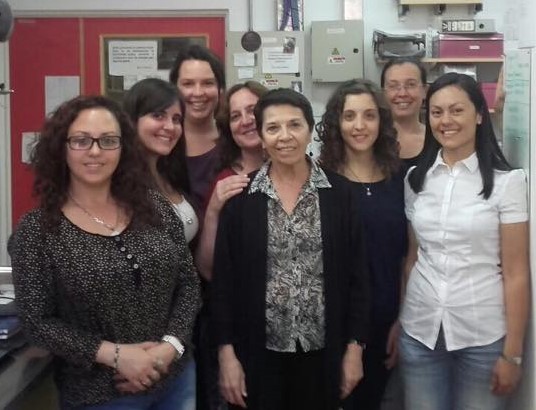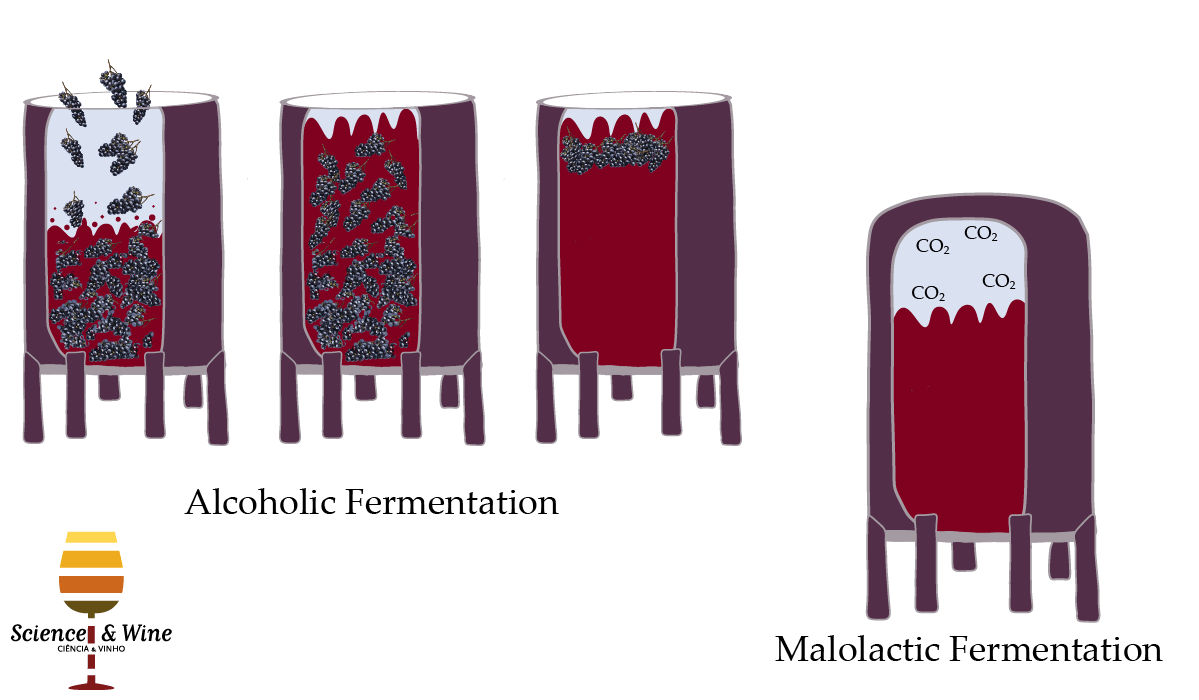By Natalia S. Brizuela, E. Elizabeth Tymczyszyn and L. Semorile
Winemaking is a complex microbial process in which yeasts and lactic acid bacteria (LAB) play a significant role. Yeasts consume sugars to produce ethanol and lead the alcoholic fermentation (AF). The malolactic fermentation (MLF) is responsible for the conversion of L-malic acid to L-lactic acid and CO2, causing a reduction of titrable acidity, and a small increase in the pH of wine. MLF also leads to enhanced microbial stability and is usually believed to improve the complexity of wine aroma, which is linked to the LAB enzymatic activity (Cappello et al., 2017; Iorizzo et al., 2016; Liu, 2002). Several organic acids, in addition to L-malic acid, could be metabolized by LAB during MLF, such as, acetic, citric and tartaric acids. The balance of organic acids has a strong impact on wine taste, being the total consumption of L-malic acid the premise to reduce acidity and astringency of wines (Volschenk et al., 2006).
Oencoccus oeni is the major bacterial species find in wines during spontaneous MLF due to high tolerance to harsh wine conditions (Wibowo et al., 1985). However, O. oeni can also be detected with other LAB, mainly Lactobacillus spp., and in particular Lactobacillus plantarum species (Lonvaud-Funel et al., 1999, Lerm et al., 2011, Bravo-Ferrada et al., 2013, Valdés La Hens et al., 2015). Some strains of O. oeni and Lb. plantarum are able to produce enzymatic reactions that modify the wine aroma profile (Cappello et al., 2017; Tristezza et al., 2016). Although the presence of a broad range of enzymes in wine LAB have been documented (glycosidases, esterases, phenolic acid decarboxylases, citrate lyases) (Liu, 2002; Ugliano et al., 2003, Matthews et al., 2004, Grimaldi et al., 2005a, 2005b), information on the role of these bacterial enzyme activities including their potential use in winemaking is still limited (Cappello et al., 2017).
Argentinean North Patagonia is one of the southernmost winegrowing regions of the world that has optimal agro-ecological conditions for high quality viticulture, in which the Pinot noir varietal has found the optimal conditions to express its full oenological potential (Crisóstomo, 2007). Although the flavor of Pinot noir wine could vary among wine regions, and according to winemaking practices, in general it has a fruity and spicy bouquet (Feng et al., 2017; Girard et al., 1997; Guinard et al., 1987). In Patagonian red wines, MLF occurs spontaneously and randomly, mainly by action of native Lb. plantarum and O. oeni strains (Figure 1) (Valdés La Hens et al., 2015).

In order to avoid delay and spoilage during this process, the use of malolactic starter cultures is an option. However, the commercial cultures are formulated with strains from other wine-growing regions and their use could negatively affect the properties of wine terroir (Bokulich et al., 2014; González-Arenzana et al., 2012). The selection of autochthonous strains, best adapted to regional winemaking conditions, is desirable.
In previous works, we have isolated and characterized several Lb. plantarum and O. oeni strains from Merlot and Pinot noir Patagonian wines, including psychrotrophic strains able to conduct microvinification assays at low temperature (10 °C) (Fig 1) (Bravo-Ferrada et al. 2013, Bravo-Ferrada et al. 2014, Valdés La Hens et al., 2015, Manera et al. 2017). Studies of tolerance to wine stress factors in wine-like medium or in sterile wine, as well as the analysis of some enzymatic activities and the screening of aroma related genes, allowed us to select the best candidate strains to formulate regional starter cultures for MLF (Bravo- Ferrada et al., 2013; Bravo-Ferrada et al., 2016; Brizuela et al., 2017; Valdés La Hens et al., 2015). We also have studied the ability of previously selected O. oeni and Lb. plantarum strains to modify the volatile compounds profile after inoculation in sterile and non-sterile Pinot noir wine. We found that O. oeni strains could produce an adequate level of diacetyl and a higher concentration of fruity esters, which are characteristics of Pinot noir wines, whereas Lb. plantarum strains showed a better capacity to consume L-malic acid (Brizuela et al., 2018).
These results allow us to suppose that properly selected strains of both species will be able to induce and successful complete the MLF, at different temperatures, could offer an interesting advantage to improve the sensory attributes and the wine quality. In order to achieve this goal, it is expected to be able to design regional malolactic starter cultures, easy to use in the winery, and able to highlight the regional terroir.
Those interested in a longer length report can download the working paper at:
https://www.sciencedirect.com/science/article/pii/S0963996917308864

Research Group:
Dr. Liliana Semorile: Head Professor UNQ, Member of Research Career of Comisión de Investigaciones Científicas de la Provincia de Buenos Aires – CIC BA
Dr. E. Elizabeth Tymczyszyn: Member of Research Career of Consejo Nacional de Investigaciones Científicas y Técnicas – CONICET
Dr. Axel Hollmann: Assistant Professor UNQ, Member of Research Career of CONICET
Dr. Danay Valdés la Hens: Assistant Professor UNQ, Member of Research Career of CIC BA
Dr. Lucrecia Delfederico: Associate Professor and Researcher UNQ
Dr. Bárbara M. Bravo-Ferrada: Assistant Professor UNQ, Member of Research Career of CONICET
Dr. Nair T. Olguín: Member of Research Career of CONICET
Natalia S. Brizuela: PhD Student CONICET
Gabriel A. Rivas: PhD Student CONICET
The academic staff of LMM is composed by specialized personnel in the areas of Biotechnology, Molecular Biology and Microbiology. Since 2007 the group is working in different aspects of the lactic acid bacteria involved in malolactic fermentations of Patagonian red wines. Currently, studies under development include the following topics:
- Preservation of native Patagonian O. oeni and Lb. plantarum strains.
- Optimization optimization of dehydration – rehydration processes of LAB strains of oenological interest.
- Evaluation of changes in the volatile profile red wines by native O. oeni and Lb. plantarum strains.
- Selection of psychrotolerant native LAB strains to formulate malolactic starter cultures suitable for fermentations at low temperatures.
- Analysis of changes involved in the bacterial adaptation to harsh wine environment.
- Application of high-throughput sequencing to evaluate the yeasts and bacterial communities associated with wines from the South of Buenos Aires province.
All these studies have been reflected in more than 100 papers in specialized journals and books chapters, over of 250 congress communications, and more than 50 research projects funded by national and international organizations. This research has been complemented with a formative activity that has been reflected in 10 defended thesis and some others to be defended shortly.
References
- Bokulich NA, Thorngate JH, Richardson PM, Mills DA (2014) Microbial biogeography of wine grapes is conditioned by cultivar, vintage, and climate. Proc Natl Acad Sci 111: E139-E148.
- Bravo-Ferrada BM, Delfederico L, Hollmann A, Valdés La Hens D, Curilén Y, Caballero, A, Semorile L (2011) Oenococcus oeni from Patagonian red wines: isolation, characterization and technological properties. Int J Microbiol Res 3(1), 48.
- Bravo-Ferrada BM, Hollmann A, Delfederico L, La Hens DV, Caballero A, Semorile L (2013). Patagonian red wines: selection of Lactobacillus plantarum isolates as potential starter cultures for malolactic fermentation. World J Microbiol Biotechnol 29(9), 1537-1549.
- Bravo‐Ferrada BM, Tymczyszyn EE, Gómez‐Zavaglia A, Semorile .L (2014) Effect of acclimation medium on cell viability, membrane integrity and ability to consume malic acid in synthetic wine by oenological Lactobacillus plantarum strains. J Appl Microbiol 116(2), 360-367.
- Bravo-Ferrada BM, Hollmann A, Brizuela NS, Valdés La Hens D, Tymczyszyn EE, Semorile L (2016) Growth and consumption of L-malic acid in wine-like medium by acclimated and non-acclimated cultures of Patagonian Oenococcus oeni strains. Folia Microbiol 61(5), 365-373.
- Brizuela NS, Bravo-Ferrada BM, Pozo-Bayón MA, Semorile L, Tymczyszyn EE (2018) Changes in the volatile profile of Pinot noir wines caused by Patagonian Lactobacillus plantarum and Oenococcus oeni strains. Food Res Int 106, 22-28.
- Brizuela NS, Bravo-Ferrada BM, Valdés La Hens D, Hollmann A, Delfederico L, Caballero A, Semorile L (2017) Comparative vinification assays with selected Patagonian strains of Oenococcus oeni and Lactobacillus plantarum. LWT-Food Sci Technol 77, 348-355. doi: 10.1016/j.lwt.2016.11.023
- Cappello MS, Zapparoli G, Logrieco A, Bartowsky EJ (2017) Linking wine lactic acid bacteria diversity with wine aroma and flavour. Int J Food Microbiol 243, 16-27.
- Crisóstomo B (2007) Caracterización fisicoquímica de mostos de uva de la Región Sur destinados a vinificación. Graduate Thesis UNCO.
- Feng H, Skinkis PA, Qian MC (2017) Pinot noir wine volatile and anthocyanin composition under different levels of vine fruit zone leaf removal. Food Chem 214, 736-744.
- Girard B, Kopp TG, Reynolds AG, Cliff M (1997) Influence of vinification treatments on aroma constituents and sensory descriptors of Pinot noir wines. Am J Enology Vitic 48(2), 198-206.
- González-Arenzana L, Santamaría P, López R, Tenorio C, López-Alfaro I (2012) Dynamics of indigenous lactic acid bacteria in wine fermentation from La Rioja (Spain) during three vintages. Environ Microbiol 63:12-19.
- Grimaldi A, Bartowsky E, Jiranek V. (2005a) Screening of Lactobacillus spp. and Pediococcus spp. for glycosidase activities that are important in oenology. J Appl Microbiol 99(5):1061-9.
- Grimaldi A, Bartowsky E, Jiranek V (2005b) A survey of glycosidase activities of commercial wine strains of Oenococcus oeni. Int J Food Microbiol 105(2), 233-244.
- Guinard JX, Cliff M (1987) Descriptive analysis of Pinot noir wines from Carneros, Napa, and Sonoma. Am J Enol Vitic 38(3), 211-215.
- Iorizzo M, Testa B, Lombardi SJ, García-Ruiz A, Muñoz-González C, Bartolomé B, Moreno-Arribas MV (2016) Selection and technological potential of Lactobacillus plantarum bacteria suitable for wine malolactic fermentation and grape aroma release. LWT-Food Sci Technol 73, 557-566.
- Lerm E, Engelbrecht L, du Toit M (2011) Selection and characterization of Oenococcus oeni and Lactobacillus plantarum South African wine isolates for use as malolactic fermentation starter cultures. S Afr J Enol Vitic 32(2), 280-295.
- Liu SQ (2002) Malolactic fermentation in wine–beyond deacidification. J Appl Microbiol 92(4), 589-601.
- López I, López R, Santamaría P, Torres C, Ruiz-Larrea F (2008) Performance of malolactic fermentation by inoculation of selected Lactobacillus plantarum and Oenococcus oeni strains isolated from Rioja red wine. Vitis 47:123-129
- Matthews A, Grimaldi A, Walker M, Bartowsky E, Grbin P, Jiranek V (2004) Lactic acid bacteria as a potential source of enzymes for use in vinification. Appl Environ Microbiol 70(10), 5715-5731.
- Miller BJ, Franz CM, Cho GS, du Toit M (2011) Expression of the malolactic enzyme gene (mle) from Lactobacillus plantarum under winemaking conditions. Curr Microbiol 62:1682-1688.
- Tristezza M, di Feo L, Tufariello M, Grieco F, Capozzi V, Spano G, Mita G (2016) Simultaneous inoculation of yeasts and lactic acid bacteria: effects on fermentation dynamics and chemical composition of Negroamaro wine. LWT-Food Sci Tech 66, 406-412.
- Ugliano M, Genovese A, Moio L (2003) Hydrolysis of wine aroma precursors during malolactic fermentation with four commercial starter cultures of Oenococcus oeni. J Agric Food Chem 51(17), 5073-5078.
- Valdés La Hens D, Bravo‐Ferrada BM, Delfederico L, Caballero AC, Semorile L (2015) Prevalence of Lactobacillus plantarum and Oenococcus oeni during spontaneous malolactic fermentation in Patagonian red wines revealed by polymerase chain reaction‐denaturing gradient gel electrophoresis with two targeted genes. Aust J Grape Wine Res 21(1), 49-56.
- Volschenk H, van Vuuren HJJ, Viljoen-Bloom M (2006) Malic acid in wine: origin, function and metabolism during vinification. S Afr J Enol Vitic 27(2):123-136. doi: 10.21548/27-2-1613.
- Wibowo D, Eschenbruch R, Davis CR, Fleet GH, Lee TH (1985) Occurrence and growth of lactic acid bacteria in wine: a review. Am J Enol Vitic 36(4), 302-313.

